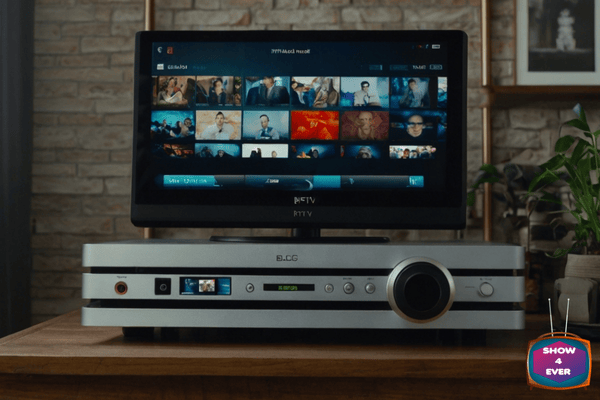What is Better Than IPTV? Exploring Next-Gen Streaming Solutions for a Superior Experience
With the ongoing demand for quality content consumption, we’ll inevitably require increasingly sophisticated streaming technologies. Internet Protocol Television (IPTV) for providing TV content via the Internet has been the means of the revolution. However, with the rapid technological advancements, the question arises: What is better than IPTV?
The world of streaming is in a constant state of flux, and alternatives often provide viewers with greater flexibility, higher video quality, and new levels of personalization. In this article, we will see the limitations of traditional IPTV services, the increasing popularity of Over the Top (OTT) platforms, the offerings of cloud streaming solutions, and finally the advantages of hybrid streaming technologies. Next, we’ll look at the exciting possibilities of the next generation of streaming solutions and figure out what is better than IPTV for next-generation viewers.
What is Better Than IPTV? The Realities of Using Standard IPTV Services.
First, let’s understand what IPTV is and its limitations. IPTV is an internet protocol-based television service that transmits live TV as well as on-demand programs through the subscription model. While this technology will be better than traditional cable or satellite TV, it is not perfect.
The one major limitation of IPTV is its reliance on a coherent, high-speed internet connection. IPTV consumes a lot of bandwidth, and any changes or slowdowns on the connection would cause buffering, lags, or poor-quality streams. And because the reliance on bandwidth can be especially vexing in regions with poor or underserved infrastructure or for users with shared network connections, it can be a major pain in the neck. When the network is congested, it quickly degrades the viewing experience dramatically, leaving the viewers unsatisfied.
Besides that, most IPTV services have limited content libraries. As compared to OTT platforms, IPTV platforms operate under restrictive licenses that do not allow them to provide various and on-demand content. Such a library can even turn out to be less satisfying for viewers who expect libraries such as Netflix Prime Video, or even Hulu.
They tend to be expensive to start with because IPTV systems tend to come with a subscription model that’s like traditional cable packages. They have to pay a premium for a bunch of channels, and some of them may not think they watch them regularly. However, a lack of personalization and flexibility leaves a lot of customers looking for a less expensive and more personal solution.
Additionally, IPTV services may be less user-friendly than OTT as many don’t provide the same level of seamless interface or personalization. Users find themselves having to deal with other clunky menus, bad recommendations, and few options to customize their viewing experience.
With the development of technology, more and more efficient, flexible, and innovative solutions have emerged to address these defects. No more are viewers bound to conventional IPTV models, and the market is filled with plenty of exciting opportunities. But what is better than IPTV? Let’s explore.
The Rise of OTT Platforms: What makes OTT better than IPTV?

Recently, in the last few years, OTT (Over the Top) platforms have made their appearance in the world and changed the way people consume media in a fundamental way. Unlike IPTV, which usually relies on closed networks and is usually connected by the use of specialized hardware, OTT platforms directly deliver content over the internet to a wide range of internet-enabled devices — including smartphones, and smart TVs. I immediately saw how convenient and flexible OTT is better than IPTV.
The vast content libraries that OTT services offer are one of the biggest advantages of them all. Unlike the traditional IPTV providers, who are bound to regional and network licensing conventions, OTT platforms like Netflix, Disney+, and Amazon Prime Video present global content including exclusive originals. But viewers are no longer stuck to what’s offered in their geographic region’s TV channels; they can explore international content from almost anywhere in the world.
As with other ways to watch, OTT platforms offer a personalized viewing experience that uses advanced algorithms to recommend shows and movies based on user preferences and viewing history. That is far more personalized than IPTV services could ever be—a rigid, one-size-fits-all service. They give power to the people using OTT to create their own viewing schedules, decide on their preferred genre, and even download the content for offline viewing. One major reason why the ad is considered better by some than IPTV is this customization.
Speaking about pricing, OTT platforms provide flexible as well as very reasonable subscription models, which are less costly than IPTV. They have options of basic, premium, and family plans, to suit and help manage their budget and needs. There are even some services that come with a clear ad-supported free option for viewers to decide between premium or cost-effective options.
One of the things that make OTT platforms potentially better than IPTV is that they are very accessible and interoperable with devices.
Specifically, OTT platforms are very different from IPTV such that they can run almost anywhere you can find a device with internet connectivity. Users can stream content on their desired devices — starting from smartphones to gaming consoles and smart TVs — without special IPTV equipment. Its versatility allows OTT to be an easier, more convenient, and more user-friendly option for modern viewers.
With all these benefits, it is obvious that OTT is a better option than IPTV. But OTT is not the only next-gen offering. And let’s take a look at some cloud-based streaming options in comparison.
Cloud-Based Streaming: Is Cloud TV the Solution to What is Better than IPTV?
In another sense, another innovative answer to the question of what’s better than IPTV is cloud-based streaming or Cloud TV. Cloud TV is extending the whole media delivery system on the cloud infrastructure so that the users will able to access the content directly from the remote server and not on local hardware or the network limitation. We are quickly approaching the age where traditional IPTV models will no longer suffice; this emerging technology provides many advantages over traditional IPTV.
Also, its scalability is one of the most compelling reasons why cloud-based streaming may be better than IPTV. This means that cloud TV works on a global network and that users can continue streaming securely, wherever they live, and without incident, regardless if the internet is from a certain provider. Since the cloud servers are located in various regions, buffering and latency problems are greatly reduced and viewing is smoother and more reliable than that from IPTV services.
Cloud TV brings in superior flexibility as well. Unlike IPTV, where you already have a fixed bunch of channels, cloud-based streaming permits the presentation of customized media involvement. This means users can join channels, services, or content categories without being forced into big, expensive packages. The “à la carte” model that cloud TV supports aligns perfectly with the growing demand for customized entertainment options.
One of the major advantages of cloud-based streaming is that it is compatible with several devices and platforms seamlessly. Unlike cable TV implementations, cloud TV services are viable on a wide range of devices — from mobile through to laptops and even smart TVs — which is very convenient. Users can begin to watch a show on their TV at home, then without any fuss pick up and continue watching on their mobile device while on the go. This kind of cross-platform flexibility is much better than IPTV’s more limited accessibility.
In addition, cloud-based streaming platforms provide additional features like real-time updates, automatic software upgrades, or even data-driven insights. This differs from IPTV, where providers may need to invest in set-top boxes or routers to keep up with the latest technology, and as a result able to offer dynamic, state-of-the-art services without having to upgrade the provider’s hardware.
The Ottawa TV platform aims to provide IPTV customers with what is better than IPTV by supporting cloud streaming as it evolves. With its scalability, flexibility, and personalization, Cloud TV offers tech-savvy consumers the next big thing in streaming technology.
What is Better Than IPTV? Hybrid Streaming Solutions for Future Proof Experience

While OTT and cloud-based platforms offer exciting alternatives to IPTV, the question remains: With the best features of all these technologies in combination, what’s better than IPTV? Hybrid streaming solutions—a next-generation idea—could be the answer, a combination of many streaming technologies into a seamless, perfect future experience.
Hybrid streaming combines broadcast TV streaming, IPTV, and OTT unified into one streaming service. Users can also, access live TV, on-demand content, and internet video streaming services via one platform. The integration of IPTV’s strong broadcast potential with OTT’s extensive content libraries plus cloud TV’s scalability offers a complete entertainment solution surpassing the capabilities of IPTV.
Unsurprisingly, one of the best things about hybrid streaming is that you can enjoy live TV alongside the flexibility of on-demand content. Hybrid platforms are critical for users who still want to watch things live (news, sports, special events) and can enjoy binge-watching whenever they like the best of both worlds. Hybrid streaming is therefore a much more well-rounded and suitable replacement for IPTV.
In terms of user experience and interface, however, hybrid models also perform very well. These platforms often offer a more user-friendly, unified interface that offers the viewer several chances to switch directly from the live to on-demand content and personalize his entertainment trip. Users don’t have to switch from one app or one device to another as they don’t need to anymore.
Hybrid streaming is also very flexible to changes in technology trends. Those are small details it can get around without the same kind of major overhaul and investment required for other streaming platforms. Hybrid models are also a promising solution for what is better than IPTV: future-proofing, keeping users at the forefront of entertainment technology without falling behind the pace of rapid innovations.
But with IPTV still holding its status as best-in-class, what could be better than that — and how could that be delivered — is a compelling answer to what the streaming landscape may be. Hybrid platforms represent a combination of the best of IPTV, OTT, and cloud streaming, offering a rounded, versatile, future-proof viewing experience for today’s consumer.
Conclusion
The need for more flexible, scalable, and personalized ways to entertain is pushing people to seek what’s better than IPTV. IPTV was a groundbreaking technology but cannot equal the OTT platforms, cloud streaming, hybrid solutions … and the landscape of streaming. Each next-gen alternative to IPTV has its advantage in addressing the shortcomings of traditional IPTV and delivering viewers with a better streaming experience.
Whether it’s the growing content libraries on OTT platforms, growing scalability of cloud TV, or interoperability of hybrid streaming solutions, these become the future of entertainment. Looking forward, streaming will only get better and better, allowing viewers greater control, choice, and customization than ever before. Perhaps the question of what is better than IPTV has as many answers, but one thing is for certain, the future of streaming is bright, dynamic, and with possibilities galore.
Share this content:














Post Comment